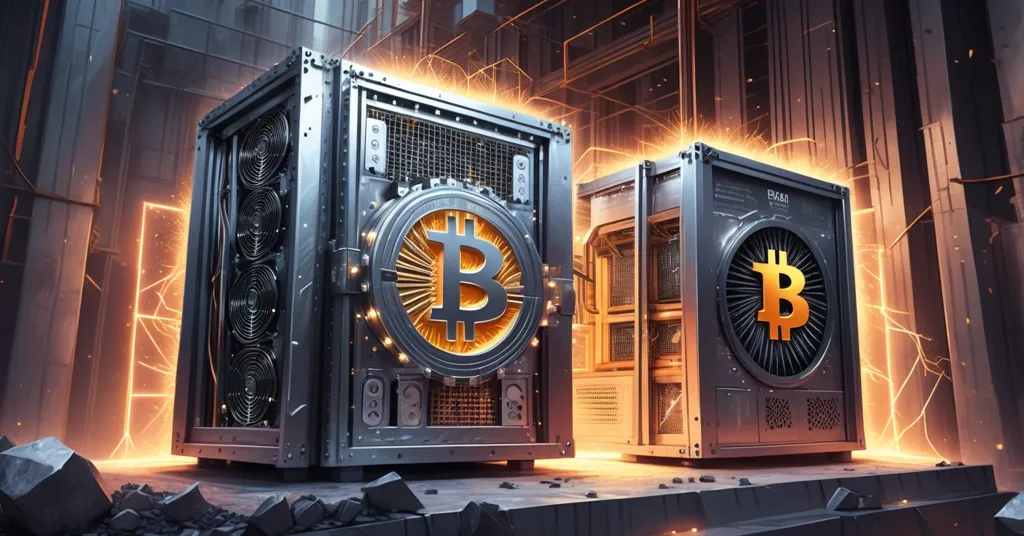Trump’s 50% Steel Tariff Hike: Impact on Bitcoin Mining Costs and Global Trade

Trump’s 50% Steel and Aluminum Tariff Hike: Global Trade Fallout and Bitcoin Mining Costs
President Donald Trump has ignited a firestorm in global trade by signing an executive order to double tariffs on steel and aluminum imports to the United States, jumping from 25% to 50% as of June 4, 2025. Framed as a shield for domestic industries and a national security necessity, this move is sending shockwaves through markets, threatening trade wars, and—surprisingly—posing risks to the cryptocurrency world, particularly Bitcoin mining infrastructure.
- Tariff Jump: Steel and aluminum imports hit with a 50% tariff, up from 25%, effective June 4, 2025.
- UK Break: UK exporters dodge the hike, sticking at 25% until negotiations by July 9, 2025.
- Crypto Hit: Rising material costs could spike Bitcoin mining hardware prices and slow infrastructure growth.
Tariff Hike: The Raw Details
The White House rolled out this policy with a clear message: America’s steel and aluminum industries need a lifeline to meet national defense demands. Under Section 232 of the Trade Expansion Act of 1962—a rarely invoked law that lets the government curb imports deemed a security threat—the administration claims foreign reliance is a glaring vulnerability. Previous tariffs at 25%, implemented during Trump’s first term, slashed imports by nearly a third between 2016 and 2020 and triggered over $10 billion in domestic mill investments. Yet, with US steel capacity utilization—a measure of how much production potential is actually used—slumping to 75.3% in 2023 from 80% in 2021, and aluminum capacity languishing at 55%, the government argues the old rate wasn’t enough. Hence, the sledgehammer approach: double it to 50%, as detailed in the official White House statement on the tariff increase.
But let’s cut through the patriotic rhetoric. US steel imports already tanked 17% between March and April 2025, and this hike will likely gut them further. Domestic firms like Independent Can Co, which imports steel from Europe, are sweating bullets. Their CEO, Rick Huether, summed up the chaos with a jab that hits hard:
“Always the question with Mr. Trump is, is this a tactic or is this a long-term plan?”
Huether’s got every damn right to be skeptical. Trump’s tariff track record is a wild card—bold moves often morph into bargaining chips. Analysts like tax policy expert Alan Auerbach from the University of California aren’t buying the quick-fix narrative either. Ramping up domestic production isn’t like flipping a switch; it takes years, and in the meantime, American consumers are staring down price hikes for everything from cars to canned goods as raw material costs soar. For a deeper dive into the policy, check this explanation of Trump’s tariff strategy.
Global Trade Fallout: A Powder Keg Waiting to Blow
Zoom out to the international stage, and the picture gets uglier. Canada and the European Union, already on the brink of retaliation after earlier US tariffs in March 2025, are gearing up for a fight. The EU, the largest steel importer after the US, could slap counter-tariffs on American goods, spiraling into a full-blown trade war. The fallout wouldn’t just sting steel exporters; it could destabilize global markets, a ripple effect even decentralized systems like Bitcoin can’t fully escape, as explored in this analysis of global trade disruptions.
The UK, for now, catches a breather, holding at the 25% tariff rate while negotiations loom by July 9, 2025, under the US-UK Economic Prosperity Deal signed in May. But don’t pop the champagne yet. Gareth Stace, Director General of UK Steel, didn’t hold back on what a potential jump to 50% would mean:
“A 50% tariff would be ‘catastrophic’ on UK exports to the US.”
Stace isn’t exaggerating. The US accounts for 7% of UK steel exports, worth over £400 million, and even the current tariffs have led to canceled orders and delayed deals. Rowan Crozier, CEO of UK-based Brandauer, admits the temporary exemption gives them an edge over global rivals, but Trump’s unpredictability is a “rollercoaster” that screws over long-term planning. It’s a mess of instability that no one can confidently navigate, as reported in this update on UK steel export exemptions.
Then there’s the head-scratcher of Trump’s suggestion to sell a United States Steel Corp plant in Pennsylvania to Japan’s Nippon Steel Corp. On one hand, it’s “America First” with a steel wall of tariffs; on the other, it’s cozying up to a foreign buyer in a politically charged swing state. Trump insists US control will remain, framing it as an “agreement” or “partial investment” rather than a full handover, but the ambiguity reeks of political theater. Details are thin, and final approval is still up in the air. Is this protectionism with a pragmatic twist, or just a stunt to woo Pennsylvania voters? Either way, it muddies the waters of an already chaotic policy, as covered in this report on the Nippon Steel deal.
Bitcoin and Crypto Infrastructure: The Unexpected Casualty
Now, let’s zero in on why this matters to our community of Bitcoin enthusiasts and blockchain innovators. Steel and aluminum aren’t just for cars and cans—they’re the backbone of the hardware powering cryptocurrency mining rigs and the massive data centers that host blockchain networks. Bitcoin mining, for those new to the game, relies on specialized machines called ASICs (Application-Specific Integrated Circuits). These are custom-built beasts designed solely to crunch the numbers that secure the Bitcoin network, often encased in metal for durability and tricked out with aluminum cooling systems to handle the heat. A 50% tariff on these raw materials could jack up production costs for manufacturers like Bitmain, potentially passing a 10-15% price hike onto buyers, much like we saw during aluminum spikes in 2018, as discussed in this report on mining cost impacts.
Picture a solo Bitcoin miner in Texas, already grappling with sky-high electricity bills, now facing a 20% bump on a new rig due to steel tariffs. That’s a real gut punch. Smaller players and startups, running on razor-thin margins, might scrap expansion plans altogether, while corporate giants like Marathon Digital can shrug off the hit. The irony? Bitcoin was born to fight centralization, yet tariffs could tilt mining power toward the big dogs, concentrating control in fewer hands. It’s a bitter pill for a community built on decentralization. Community discussions, like those on Reddit about tariff effects on mining hardware, highlight these very concerns.
Decentralized Solutions: A Satoshi-Sized Workaround?
Here’s where we flip the script with some optimism—and a nod to the disruptive grit we live for. Blockchain technology could be the steel-sharp tool to slice through trade war chaos. Decentralized platforms, especially on networks like Ethereum with their robust smart contract capabilities, can revolutionize supply chains for industries like steel and aluminum. Imagine an importer tracking shipments on an immutable ledger, verifying provenance to dodge tariff disputes, or auto-executing payments via smart contracts based on real-time trade policies. No more bureaucratic quicksand—just transparent, efficient deals coded into reality.
Projects like IBM’s TradeLens, though now defunct, showed early promise in this space by digitizing shipping records on a blockchain. A steel exporter could, in theory, use an Ethereum-based system to reroute shipments or adjust pricing instantly if the US slaps on a new tariff. It’s the kind of innovation that aligns with our push for effective accelerationism (e/acc)—speeding progress by smashing outdated systems. Bitcoin might be the unassailable king of decentralized money, but altcoins and protocols like Ethereum fill critical niches, solving real-world frictions BTC isn’t built for.
Let’s not get carried away with hopium, though. Adoption of blockchain by traditional industries is slower than a 2017 Bitcoin transaction during peak fees. Steel magnates aren’t rushing to pivot to Ethereum overnight—scalability issues, regulatory gray zones, and plain old tech illiteracy stand in the way. Plus, even if supply chains go decentralized, the hardware cost problem for crypto itself doesn’t vanish. Tariffs could still choke the pipeline we rely on to build the future.
Playing Devil’s Advocate: Is Protectionism Worth the Pain?
I’ll tip my hat to the spirit of self-reliance behind Trump’s tariffs—it vibes with Bitcoin’s ethos of breaking free from overbearing systems. Protecting US industry sounds noble, even badass. But let’s be real: if it jacks up costs across the board, hammering everyone from steelworkers to solo miners, is it worth the trade-off? Higher consumer prices and global trade fractures could drag down economic stability, a storm even Bitcoin’s decentralized armor can’t fully weather. And don’t get me started on the Nippon Steel deal—handing off a domestic asset while preaching “America First” smells like hypocrisy or, at best, a half-baked political ploy.
For our crypto crowd, the darker side looms large. Could these tariffs slow the very revolution we’re fighting for by pricing out the little guy? If data center builds stall or mining becomes a rich man’s game, we risk losing the grassroots heart of this space. And a heads-up: watch out for shady “experts” hawking tariff-proof mining rigs or trade-war altcoins. It’s just another pump-and-dump scam dressed up in crisis clothing. We’ve got zero tolerance for grifters here. For insights into broader market implications, see this discussion on tariffs and crypto markets.
What’s Next for Crypto Amid Trade Tensions?
This tariff saga is a double-edged sword. It champions American grit, echoing the independence we stack sats for, yet it risks alienating allies, burdening everyday folks, and sideswiping the decentralized infrastructure we’re hustling to build. Could Trump’s hardline stance accidentally push industries toward blockchain transparency to dodge trade chaos, or will it just strangle the hardware lifeline our space depends on? That’s the million-Bitcoin question.
We’re not peddling baseless predictions or doom porn. The reality is messy, much like a BTC price chart during a flash crash. Trade policies don’t operate in a bubble—they seep into every corner, including the financial rebellion we’re rooting for. Whether you’re a Bitcoin maximalist or dabbling in Ethereum’s latest upgrade, keep your eyes wide open. The clash between old-school trade wars and cutting-edge tech is where the true fight for freedom and disruption is heating up. For more on the initial announcement, refer to this report on Trump doubling tariffs.
Key Takeaways and Questions
- What’s driving Trump’s 50% steel and aluminum tariff hike in 2025?
The policy, effective June 4, 2025, seeks to safeguard US industries and national security by cutting reliance on foreign metals vital for defense. - How might Trump’s tariffs impact Bitcoin mining costs?
Surging steel and aluminum prices could raise the cost of mining hardware like ASICs and data center setups, hitting smaller Bitcoin miners hardest. - Can blockchain technology address trade disruptions from tariffs?
Absolutely, decentralized platforms on networks like Ethereum could boost supply chain transparency and automate compliance with smart contracts, adapting to trade rules instantly. - What risks do these tariffs bring to global trade and crypto markets?
Retaliation from Canada and the EU could ignite a trade war, fostering economic instability that might slow crypto infrastructure growth, even in decentralized ecosystems. - Why is the UK spared from the 50% tariff for now?
The UK holds at a 25% rate until negotiations wrap by July 9, 2025, under a recent US-UK trade pact, providing temporary relief amid global tensions. - Could tariffs hinder decentralized tech growth in crypto?
Potentially, as rising hardware costs might delay data center expansions for blockchain projects, especially for startups unable to match the deep pockets of larger players.



